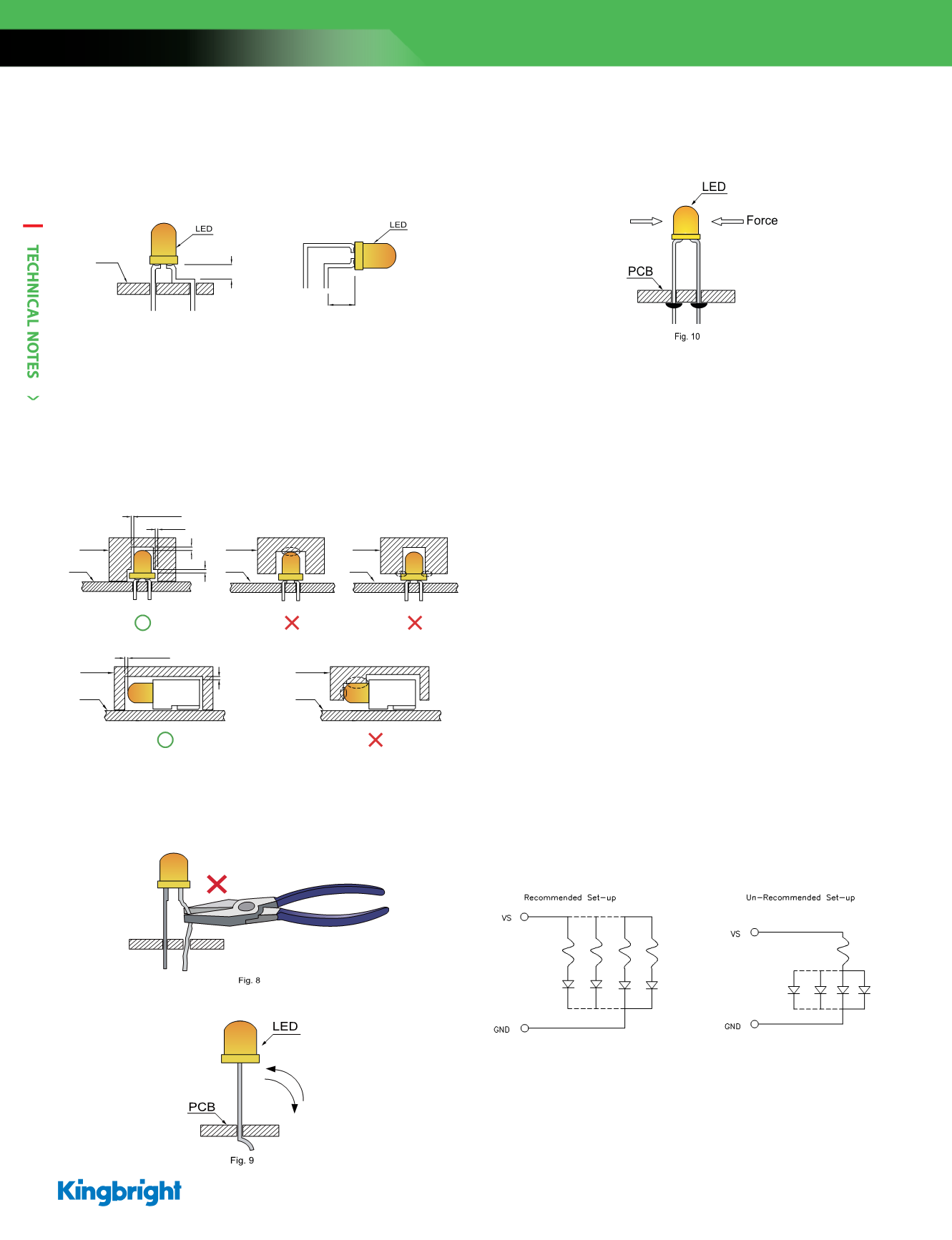
TECHNICAL NOTES
88
Lead Forming Procedures
1. Maintain a minimum of 3mm clearance between the base of the LED
lens and the first lead bend. (Fig. 5 and 6)
2. Lead forming or bending must be performed before soldering, never
during or after soldering.
3. Do not stress the LED lens during lead-forming in order to prevent
fractures in the epoxy lens and damage the internal structures.
4. During soldering, component covers and holders should leave
clearance to avoid placing damaging stress on the LED during
soldering. (Fig. 7)
5. During lead forming, use tools or jigs to hold the leads securely so that
the bending force will not be transmitted to the LED lens and its internal
structures. Do not perform lead forming once the component has been
mounted onto the PCB. (Fig. 8)
7. After soldering or other high-temperature assembly, allow the LED
to cool down to 50°C before applying outside force (Fig. 10). In general,
avoid placing excess force on the LED to avoid damage. For any
questions please consult with Kingbright representative for proper
handling procedures.
Cleaning
1. Do not use harsh organic solvents for cleaning because they may cloud
or damage the LED lens.
2. Isopropyl alcohol or deionized water are recommended solvents for
cleaning.
3. Special attention should be taken if other chemicals are used for
cleaning because other solvents may damage the epoxy in the lens
or housing.
4. The cleaning process should take place at room temperature and the
devices should not be washed for more than one minute.
5. When water is used for cleaning, immediately use forced-air drying to
remove excess moisture from the LED.
6. Do not use acidic solvents or unknown chemicals to clean the
component. Before using any cleaning solvent, check to insure the
chemical composition will not corrode or damage epoxy resin,
organosilicates, silicone resin, and silver plating, in order to prevent
accidental damage or degraded function.
7. Typically we suggest ethanol for cleaning SMD LEDs. Lightly wipe
away any surface contaminants and avoid excessive force that might
damage the lens surface or internal structures. Allow to dry under room
temperature conditions before further usage. Do not soak the SMD
LED in ethanol or other solutions.
Miscellaneous Design Notes
1. Protective current-limiting resistors may be necessary to operate the
LEDs within the specified range.
2. LEDs mounted in parallel should each be placed in series with its own
current-limiting resistor.
3. The driving circuit should be designed to avoid reverse voltages and
transient voltage spikes when the circuit is powered up or shut down.
4. High temperatures can reduce device performance and reliability. Keep
LED devices away from heat source for best performance.
5. The safe operation current should be chosen after considering the
maximum ambient temperature of the operating environment.
6. Do not bend the leads more than twice. (Fig. 9)
4. Do not route PCB trace in the contact area between the leadframe and
the PCB to prevent short-circuits.
Application Notes
MIN.
MIN.
PCB
3mm
3mm
Fig. 6
Fig. 5
Fig. 7
0.5mm MIN.
0.25mm MIN.
0.25mm MIN.
HOLDER
HOLDER
HOLDER
HOLDER
HOLDER
0.5mm MIN.
0.5mm MIN.
0.5mm MIN.
PCB
PCB
PCB
PCB
PCB


